[ad_1]
Unlike traditional yoga poses, which have the goal of building strength and flexibility, restorative yoga poses offer a slower, more restful approach that quite literally relaxes every muscle in your body. Whether you’re hoping to reduce stress or improve your sleep, the benefits from finding inner balance through restorative yoga feel never-ending.
Below, you’ll learn the ins and outs of this calming practice, how adding restorative yoga to your weekly routine can better your health and well-being, and the relaxing yoga postures to start with.
What is restorative yoga?
When you think of yoga, you may picture an instructor leading you through a rejuvenating yoga sequence that has you bending into various poses, from downward-facing dog to warrior.
“Traditional yoga focuses on postures (asanas) breathing exercises (pranayama), and meditation (dhyāna),” says Nicole Vincent, general manager and lead teacher at YogaSix North Carlsbad.
Restorative yoga, on the other hand, requires very little movement, allowing you to settle into gentle poses for deep relaxation.
“Restorative yoga focuses on bringing the nervous system into a state of relaxation,” Vincent says. “You’ll spend more time in a few postures using props—such as blankets, bolsters, blocks, and straps—to support your body so that you can sink deeper into relaxation.”
You may be wondering: What’s the difference between restorative vs. yin yoga? While the two seem quite similar, as they both involve holding poses for extended periods of time, they have some major differences.
Restorative yoga involves doing supported yoga postures for relaxation that require you to exert little to no effort. This allows you to find healing and stress relief through restorative yoga.
With yin yoga poses, you’re targeting the deeper connective tissues with the goal of stretching and lengthening your muscles. While beneficial to flexibility and joint mobility, this makes yin yoga more uncomfortable than restorative yoga.
The benefits of restorative yoga
Numerous benefits can come from slowing things down and melting into relaxing yoga postures. Here are some positives restorative yoga may bring you, from boosting your immune system to helping you sleep.
1. It reduces anxiety and stress
Whether you’re dealing with stress or anxiety, you can calm your mind with restorative yoga. But how can you find stress relief through restorative yoga, exactly? Cortisol is the body’s primary stress hormone, and consistently high levels can affect your mental health, according to the Mayo Clinic.
“By giving your body and mind the time to relax, you’ll improve your adrenal function,” Vincent says. “This will repair the mind-body connection and balance your nervous system.”
2. It improves sleep
If you’re hoping to sleep like a baby, restorative yoga can help. The practice involves doing gentle poses for deep relaxation—which is basically a soothing lullaby for your mind and muscles, according to Vincent.
“Restorative yoga poses are supported with different props so that the body can release muscular tension,” she says. “Incorporating a few restorative yoga postures before bedtime can help your mind and body relax so that you can ease into a restful sleep.”
3. It boosts your immune system
Achieving inner balance through restorative yoga can greatly benefit your immune system.
“Having too much cortisol in your blood can lead to inflammation and a weakened immune system,” Vincent says.
Restorative yoga is an effective way to reduce those levels, helping to calm and balance your nervous system, per a December 2017 research review in the journal Psychoneuroendocrinology.
4. It supports healing and recovery
As the name suggests, restorative yoga helps “restore” your body. Aside from helping with stress and anxiety and boosting your immune system, it’s also a great option for anyone who’s dealing with an injury.
Because you utilize so many different props during each rejuvenating yoga sequence, you’re able to adjust each pose to your specific needs and comfort level. (If you’re looking for yoga for trauma, restorative could be a great option for healing, too.)
“Incorporating a few restorative yoga postures before bedtime can help your mind and body relax so that you can ease into a restful sleep.” —Nicole Vincent, lead teacher at YogaSix North Carlsbad
5 restorative yoga poses to try
Reaping the benefits of restorative yoga is easy. Vincent says to do the supported yoga postures for relaxation below at least three times a week.
“You can easily incorporate a few poses as part of your bedtime routine or in your cooldown at the end of a workout,” she says.
Below, Vincent guides you through her favorite restorative yoga poses for beginners with props and modifications that will leave you feeling extra supported and relaxed.
1. Legs up the wall pose (Viparita Karani)
Legs up the wall is one of the best gentle poses for deep relaxation. You’ll be able to get some stress relief through restorative yoga anywhere, anytime—all you need is a place to put your legs up.
“If wall space isn’t available, you can rest the lower half of your legs over a chair or sofa,” Vincent says.
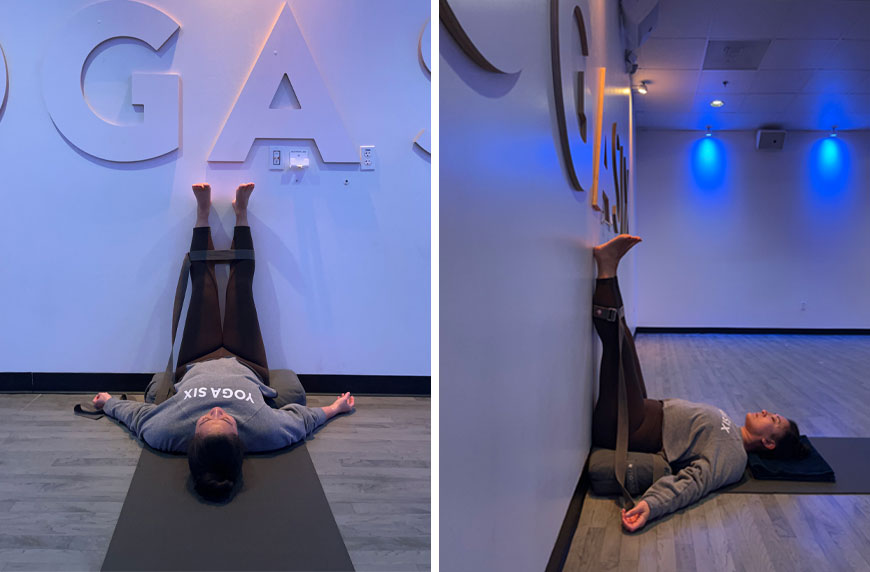
- Place your yoga mat perpendicular to a wall and place a cushion right up against the wall.
- Sit with your left side against the wall.
- Gently turn your body to the left and carefully swing your legs up the wall.
- Lower your back to the floor and lie down. Rest your shoulders and head on the floor.
- Let your arms relax by your sides at an angle that feels comfortable for you.
- Take deep breaths into your belly and long, slow exhalations to calm your nervous system.
- After five to 10 minutes, draw your knees into your chest and roll to one side. Take a moment to pause before slowly coming up to a seated position.
To support your body in relaxing into this pose, you could use:
- A pillow or bolster under your lower back
- A blanket or rolled towel under your head to support your neck
- A strap or band around your calves for your legs to rest into
- An eye pillow or eye mask if the light is bright in your space
2. Supported fish pose (Matsyasana)
The fish pose opens up and relieves tension in your upper body, making it a great supported yoga posture for relaxation. If you’re looking for restorative yoga poses for beginners with props, you can utilize a bolster or pillow to ensure you’re able to fully sink in.
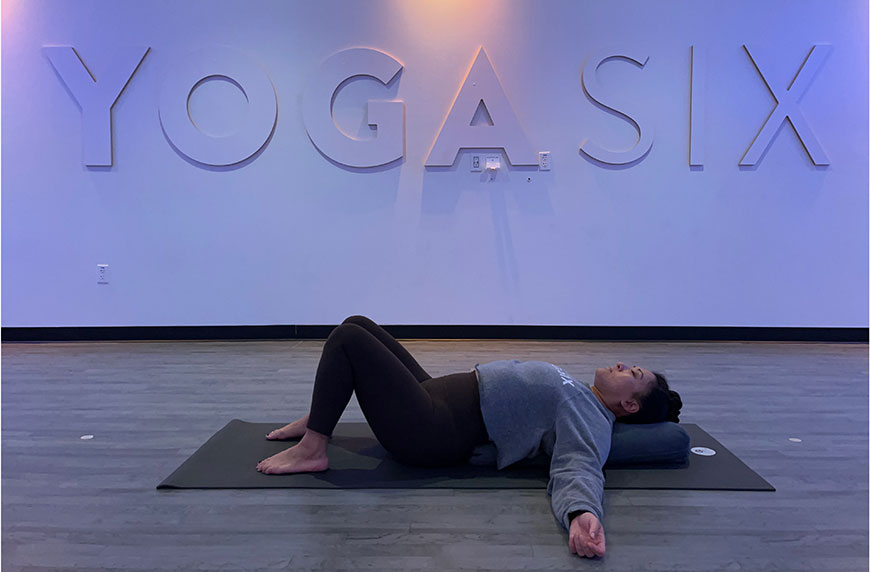
- Sit in front of the short end of your bolster or pillow. It should be touching your tailbone.
- Use your arms for support as you lie back on your bolster. Your entire spine and head should be supported. Bend your knees, extend them long, or place your feet together with your knees open like a book—whichever position is most comfortable for you.
- Relax for 10 to 15 minutes. Use your hands to sit up slowly. Take a moment to pause before moving.
To support your body in relaxing into this pose, you could use:
- Blocks under the bolster to create more of an incline
- An eye pillow or eye mask if the light is bright in your space
3. Supported child’s pose (Balasana)
You probably already know and love child’s pose from your regular yoga classes. But this supported yoga posture for relaxation uses a bolster or pillow to take the experience to the next level, allowing you to fully unwind and every second.
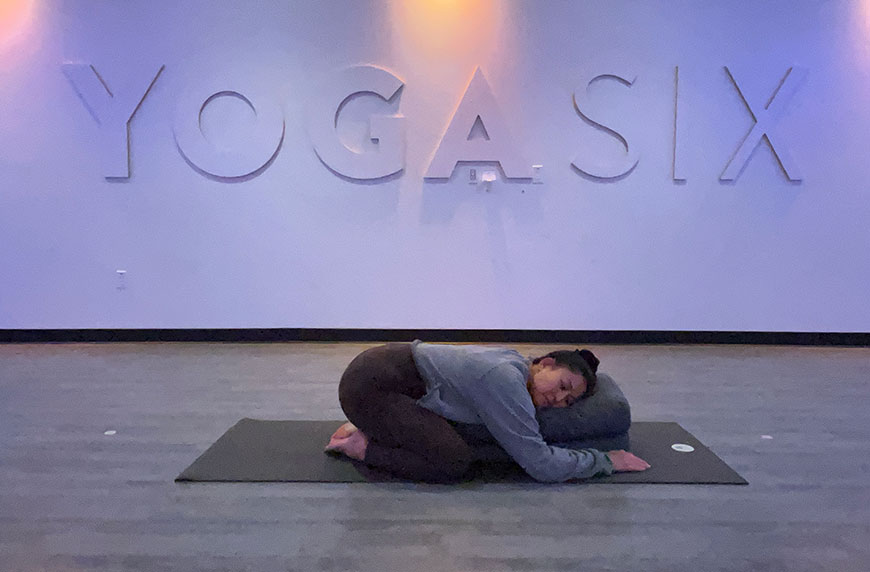
- Kneel with your knees hip-width apart and big toes close together.
- Slide one to two bolsters or pillows lengthwise between your thighs.
- Sit back on your heels and rest your belly, chest, and head on your bolster.
- Practice for six to 10 minutes, making sure to turn your head to one side halfway through.
- To come out of the pose, place your hands on the floor under your shoulders and press up slowly to sit on your heels. Take a moment to pause before moving.
To support your body in relaxing into this pose, you could use:
- Blankets or padding under your shins and knees
- A sandbag on your low back to help relax the muscles of your lower back
- A towel rolled lengthwise placed under the front of your ankles so your feet can hang over to allow more flexion of your ankles
- A blanket or towel rolled lengthwise placed between the back of your legs and back of your calves/ankles to reduce compressing in your knees
4. Supported reclining twist pose (Supta Matsyendrasana)
This restorative yoga pose for beginners with props allows you to utilize pillows or a rolled blanket in order to keep your body completely at ease.
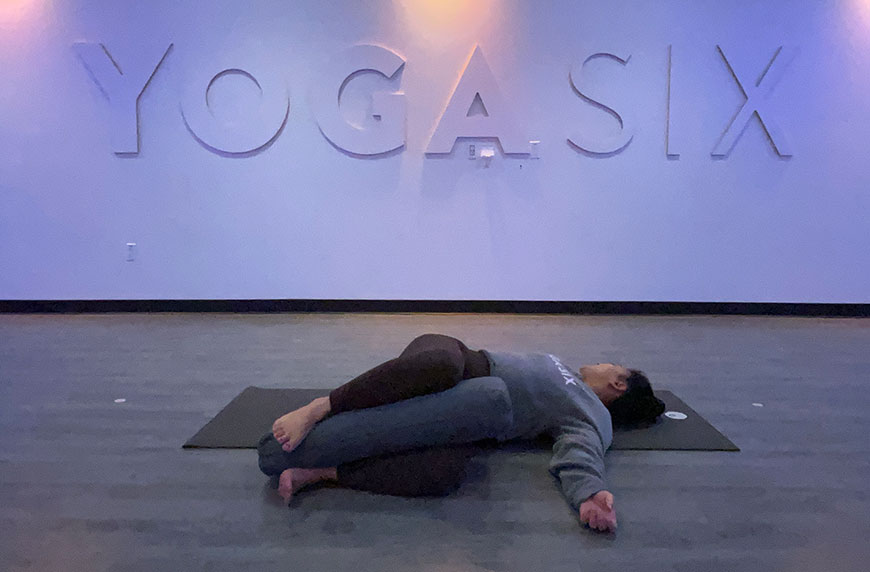
- Start lying flat on your back.
- Bend both legs toward your chest, then let them fall to one side. Stack your knees and hips.
- Extend your arms straight out at shoulder level and turn your head in the opposite direction from your knees.
- Close your eyes and relax your jaw and belly. After three to five minutes, switch sides.
- To come out, draw your knees to your chest then slowly lengthen them one at a time. Take a moment to pause before moving.
To support your body in relaxing into this pose, you could use:
- One or two pillows between your thighs
- A blanket or rolled towel under your head to support your neck
5. Corpse pose (Savasana)
Ahh, Savasana. Calming the mind with restorative yoga is a breeze with this classic move that allows you to lie on your back and enter a deep state of deep relaxation.
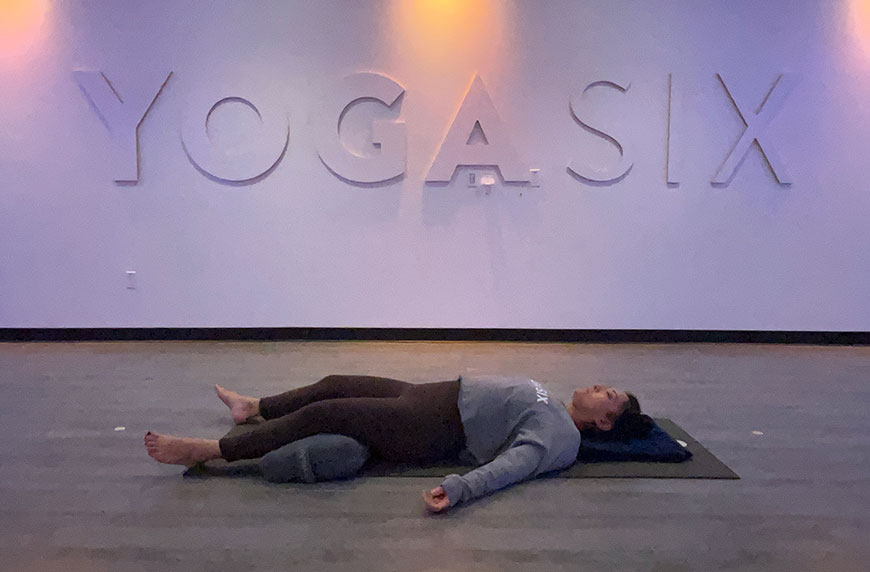
- Lie on your back with your arms out to the side and legs comfortably apart.
- Relax and breathe for five to 20 minutes.
- To come out, first bring small movements to your hands and feet. Bend your knees and roll over to one side.
- Rest in this position until you feel ready to sit up. Take a moment to pause before moving.
To support your body in relaxing into this pose, you could use:
- A bolster under your knees
- A blanket or towel under your head to support your neck
- An eye pillow or eye mask if the light is bright in your space
- Cover yourself with a blanket for warmth
FAQ
1. Who should not do restorative yoga?
This gentle yoga practice is truly for everyone, according to Vincent. With that being said, even though many find they can calm their mind with restorative yoga, she notes that for some individuals, the “practice of being still could provoke a more agitated mind because it has fewer things to focus on.” But that’s something you shouldn’t be afraid of.
“Holding these passive poses allows you to turn your attention inward, causing any emotions to become your focus,” she says. “Incorporating restorative poses at the end of a more physical practice would be a good way to ease an active mind to prepare for relaxation.”
2. How long should you hold restorative yoga poses?
The amount of time you hold should hold different relaxing yoga postures varies. For example, when going about your rejuvenating yoga sequence, Vincent recommends holding the legs up the wall pose for five to 10 minutes, the supported fish pose for 10 to 15 minutes, and corpse pose for five to 20 minutes. With that being said, always listen to your body and do whatever feels best to you.
Well+Good articles reference scientific, reliable, recent, robust studies to back up the information we share. You can trust us along your wellness journey.
-
Pascoe MC, Thompson DR, Ski CF. Yoga, mindfulness-based stress reduction and stress-related physiological measures: A meta-analysis. Psychoneuroendocrinology. 2017 Dec;86:152-168. doi: 10.1016/j.psyneuen.2017.08.008. Epub 2017 Aug 30. PMID: 28963884.
[ad_2]
Source link
